Dock cranking
Try this reaction tactic to fool dock-dwelling bass this fall
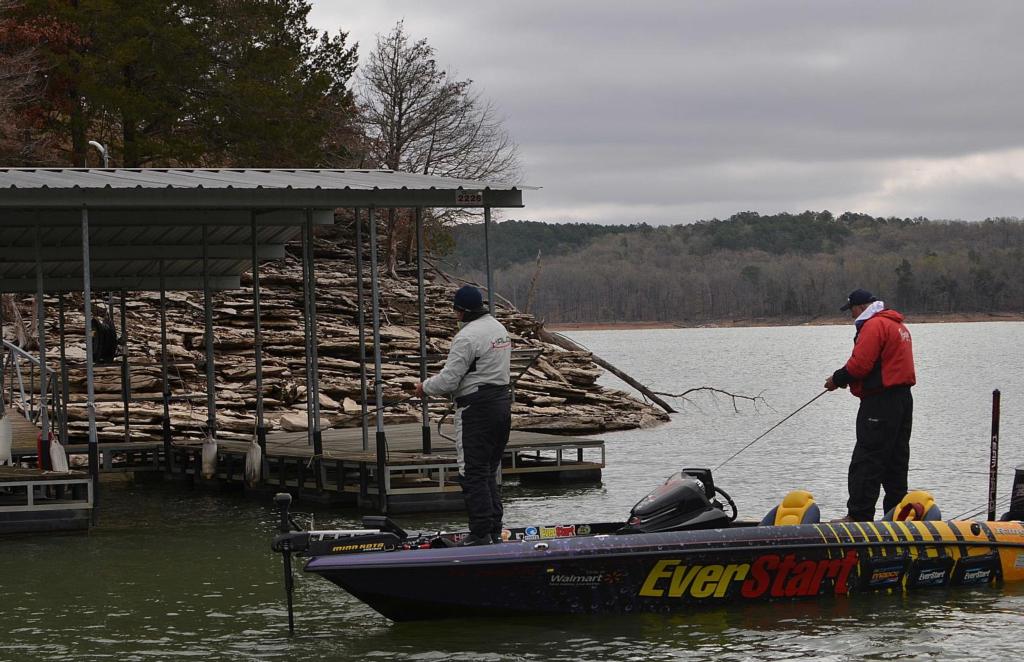
(Editor’s note: This article originally appeared in the 2013 October issue of Bass Fishing magazine. To read more compelling articles from Bass Fishing magazine each month, become an FLW subscriber member. If you’d like to sign up for a digital subscription to access articles online, click here).
You fish crankbaits in shallow water. You fish docks in shallow water. But do you ever fish shallow docks with crankbaits?
If your answer is yes, then you probably already know how effective crankbaits can be for drawing reaction bites from dock-dwelling bass.
If you answered no, then you’re missing out. Crankbaits might not seem to be the best choice for fishing docks, given their snaggy support structure, but such hazards can be overcome. All else being equal, crankbaits are great for fishing docks for the same reason they’re great for fishing just about anywhere else: they trigger strikes. The fact that bass seldom see crankbaits under docks and consequently might be more susceptible to them is another reason for anglers to try them there.
To be sure, well-honed casting skills are required to send a crankbait deep into the reaches of a dock. It can’t be skipped on the surface easily, but even an average caster can make a crankbait go where dock bass are likely to be if he employs a trick that Walmart FLW Tour pros Bryan Thrift and Wesley Strader call “driving,” or “steering.” By using the rod tip to direct the crankbait on a path in one direction or the other – or even opposite directions on the same cast – you can guide the lure to make contact with posts, cross members and other parts of a dock that bass use as cover.
What you get is a unique presentation that offers control like few other lures – not a bad combination.
Casting class
Learning to cast crankbaits under docks is like learning to ride a bike without training wheels: When you screw up, it hurts. But that’s OK. Knowing that the hooks of a crankbait are exposed provides extra incentive for you to be more precise and careful, which is what’s necessary in order to get the lure into tight, hard-to-reach spots under docks.
The best casts are backhand or sidearm roll-casts that keep the lure close to the water and accelerating quickly. Skipping a crankbait is not impossible, but it’s also not practical. Dangling hooks and the bill tend to “grab” the water and halt forward motion, which usually results in a backlash. So the key is to make low, direct casts just above the water’s surface. Feathering the spool with your thumb helps to guide the crankbait into just the right spot.
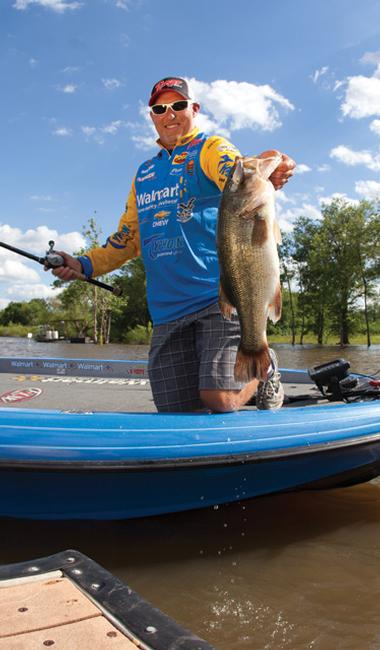 Rod selection plays a critical role in this technique, more so than many others. A rod too long is cumbersome in tight spaces, and a rod too stiff will rip out the hooks when a fish strikes. It’s important to find a rod that balances moderate backbone with medium length.
Rod selection plays a critical role in this technique, more so than many others. A rod too long is cumbersome in tight spaces, and a rod too stiff will rip out the hooks when a fish strikes. It’s important to find a rod that balances moderate backbone with medium length.
“I like to use a 723 Powell,” Strader says. “Basically it’s just a medium-action rod, more like a spinnerbait rod. If I know I’m going to be backhanding a lot, I’ll go with a 683 Powell rod.”
The distinction is based on the space between the dock and the water’s surface. The 723 model is 7 feet, 2 inches long, and Strader uses that when he’s got 3 to 5 feet of space under the dock (common on many fixed-type docks, especially in low-water periods such as fall) and can roll-cast with ease. When the gap is smaller, he swaps for the 683, which is 6 feet, 8 inches long.
Thrift uses a shorter rod almost all the time. He opts for either a 6-foot, 9-inch or 6-foot, 6-inch medium-heavy Damiki rod. The extra strength of the medium-heavy, coupled with heavier-wire hooks that he puts on the crankbait, helps to get the fish headed out of the dock and surrounding cover in a hurry.
Steer clear
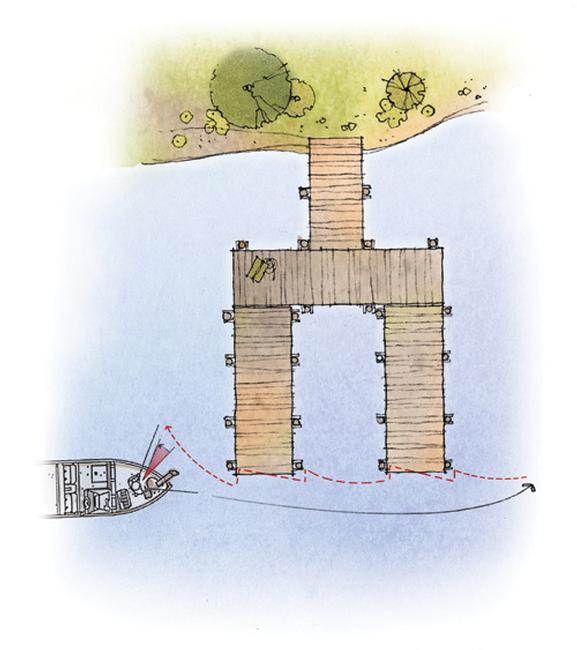 Anglers mainly rely on such popular dock-fishing lures as jigs or Texas rigs because they facilitate the most important part of the cast – the initial fall. If you can skip a lure into tight quarters that other anglers are likely to have missed, you’ve pretty much made the best bid you can.
Anglers mainly rely on such popular dock-fishing lures as jigs or Texas rigs because they facilitate the most important part of the cast – the initial fall. If you can skip a lure into tight quarters that other anglers are likely to have missed, you’ve pretty much made the best bid you can.
When dock-fishing with crankbaits, however, the retrieve is just as important as the cast. Enticing fish to come after the lure requires making contact with part of the dock structure or any cover under it. The best way to do it is to “drive” the crankbait, which means using the rod to steer the lure into part of the dock during the retrieve. You can do this with other lures, such as swimbaits and swim jigs, but because crankbaits float, they allow you the time to set up for the retrieve and offer better speed control.
Set up for the contact by casting 5 or 6 feet past the object you want to hit. This gives you enough retrieve time to get the crankbait down and direct it the right way. If you cast to the left of a post and want to make contact with the post, point the rod out to the right of it. The crankbait will try to follow the line in that direction, and as it comes around the post it will deflect. That’s what triggers strikes.
Fishing this way takes some creativity. You have to plan the attack based on where you can cast and the best line of retrieve. Both parts are important.
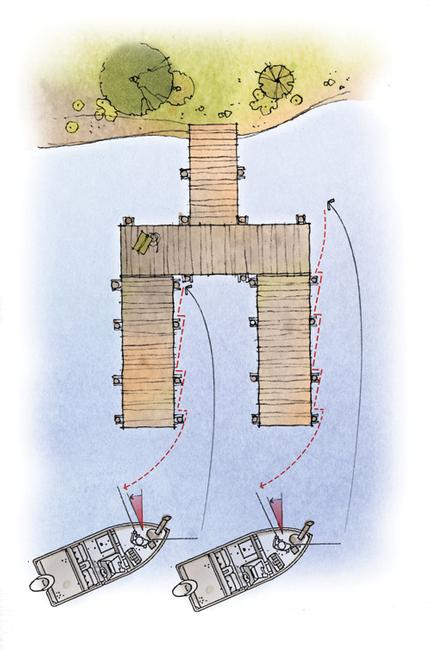 You can also find ways to fish crankbaits on docks that don’t require fine-tuned casting skills. Instead of always casting far under docks, try casting parallel to docks, then maneuvering the boat slightly to the side so that your retrieve brings the lure alongside the structure, where it can deflect off several posts along the way. And corner posts are easy. Just cast across the corner, hold the rod out beyond the dock so your line lands in the water, bring the rod back over and retrieve the crankbait back so it hits the corner post. Use this method to fish beneath the corners of floating docks as well.
You can also find ways to fish crankbaits on docks that don’t require fine-tuned casting skills. Instead of always casting far under docks, try casting parallel to docks, then maneuvering the boat slightly to the side so that your retrieve brings the lure alongside the structure, where it can deflect off several posts along the way. And corner posts are easy. Just cast across the corner, hold the rod out beyond the dock so your line lands in the water, bring the rod back over and retrieve the crankbait back so it hits the corner post. Use this method to fish beneath the corners of floating docks as well.
Try to take advantage of the “reaction-bite” presentation of the crankbait. Thrift suggests a fast retrieve. And you can add action during the retrieve if you aren’t able to contact the dock every time.
“Sometimes I like to twitch it, wind it, stop it, twitch it – the same way as you would a jerkbait,” Strader says.
Both pros prefer 12- to 15-pound-test fluorocarbon because it can handle the friction of rubbing against the dock structure. An abrasion-resistant line is critical. Check it often for nicks.
When it works
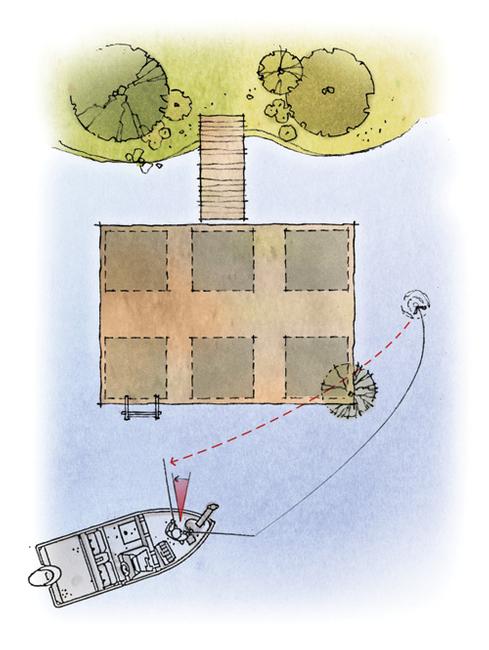 Strader and Thrift agree that there are two scenarios when crankbaits excel for dock-fishing: early spring, when bass are “staging up” to spawn, and again in fall. Both are transition periods, when bass are moving in or out of creeks. Docks are well-used stopping points along the way in either direction.
Strader and Thrift agree that there are two scenarios when crankbaits excel for dock-fishing: early spring, when bass are “staging up” to spawn, and again in fall. Both are transition periods, when bass are moving in or out of creeks. Docks are well-used stopping points along the way in either direction.
Cranking docks is primarily a shallow pattern, more productive around docks on flats or in the backs of creeks in about 5 feet of water or less. Otherwise, look for conditions that typically would suggest using a crankbait – murky to muddy water, for instance. Situations where the bank is mostly mud or soft bottom with little cover for bass to set up on are ideal, because the docks become even more attractive since they are the best – perhaps only – cover in the area.
Permanent docks that are footed in the lake’s bottom with pilings or wooden posts are the best for fishing a crankbait because there’s usually a space underneath for making the cast and the thick pilings constitute great fish-holding cover. But floating docks can also be fished with crankbaits. Look for brush that lakeside homeowners have placed around their floating docks. Also be on the lookout for bass suspended underneath the plastic floats.
Best baits
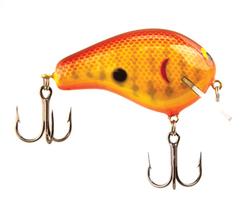 Crankbaits offer several advantages over other dock-fishing lures such as jigs and spinnerbaits. Crankbaits run at a specific depth. So you can match the lure to the water depth, as well as matching the color of the lure to the local forage. Also, crankbaits aren’t as commonly used to fish docks, which means that bass might be more susceptible to them.
Crankbaits offer several advantages over other dock-fishing lures such as jigs and spinnerbaits. Crankbaits run at a specific depth. So you can match the lure to the water depth, as well as matching the color of the lure to the local forage. Also, crankbaits aren’t as commonly used to fish docks, which means that bass might be more susceptible to them.
“They [bass] don’t see a crankbait as often as they do a jig or a spinnerbait,” Strader says. “It’s a completely different action. It throws a lot of vibration.”
“If the fish are up shallow, sometimes you can get them to react to a crankbait, but they’ll let a jig or Texas rig go by them if it’s moving slow,” adds Thrift.
The pros prefer shallow square-bill crankbaits because they deflect better than other types of crankbaits.
“I really like a Bagley Balsa B2 and Balsa B1,” Strader says.
“I like the Damiki DC-100,” Thrift says. “It’s a heavy crankbait, so you can really get it way under the dock. It’s still buoyant, but it has enough weight where you don’t have to make a hard cast under there. You can just roll your wrist. If you were casting a light wooden bait you would have to cast it too hard and can’t get the low trajectory that you need on the cast.”
Fish and fish again
One big advantage of the crankbait over other dock-fishing lures is the speed at which it can cover water. You can burn the bank between docks and pick apart each dock structure quickly, yet carefully.
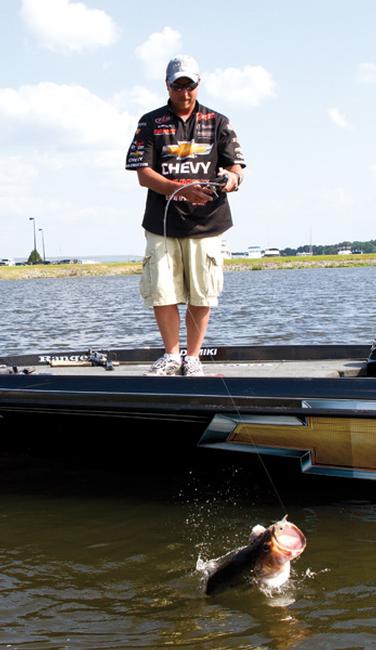 “I always start my day just covering water, because that’s what the crankbait is designed to do,” Thrift says. “Once you start getting bites you can tell where they’re going to be, whether on outside posts or way up under. And if you hit a piece of brush you want to make multiple casts to that. You need to rule out where they aren’t.”
“I always start my day just covering water, because that’s what the crankbait is designed to do,” Thrift says. “Once you start getting bites you can tell where they’re going to be, whether on outside posts or way up under. And if you hit a piece of brush you want to make multiple casts to that. You need to rule out where they aren’t.”
More so in the fall than the spring, it pays to make multiple presentations on the best docks. Strader and Thrift both use this technique.
“You’re going to try to hit everything you can, especially in the fall,” Strader says. “If I know the fish are really keying on the corner, I might pull up to the dock and make 15 casts to the same corner. When you’re going through that transition from summer to fall and they’re really keyed in on that bait, sometimes it just takes a lot of casts to get that fish to eat.”
Whether bass are feeding aggressively or are a bit sluggish, repeated casts with a crankbait can get the job done around shallow docks. Its reaction-bite action triggers bass to strike, especially when they haven’t seen such a presentation under their dock before.
Set up for success
 One of the simplest ways to increase your dock-casting accuracy is to stabilize your boat before the cast. Power-Poles are ideal for this. They allow you to stop the boat in place and cast without having to man the trolling motor. This is tremendously helpful in windy conditions.
One of the simplest ways to increase your dock-casting accuracy is to stabilize your boat before the cast. Power-Poles are ideal for this. They allow you to stop the boat in place and cast without having to man the trolling motor. This is tremendously helpful in windy conditions.
“Power-Poles have made a tremendous difference in the way you fish a dock,” Walmart pro Wesley Strader says.” You can pull up to the dock, come in from the windy side, push them down and fish that whole dock.”
In dingy water, it’s possible to stay up close to the dock and cast. But in “medium” water clarity conditions, it’s best to keep your distance. Sometimes a little extra distance also offers a better casting angle. So try to select the best distance from a dock based on ease of casting and water clarity. According to Chevy pro Bryan Thrift, casts are usually no more than 30 to 40 feet long.